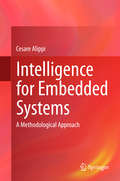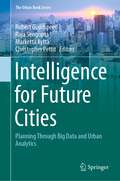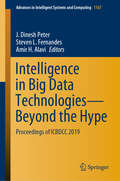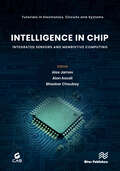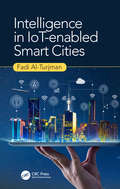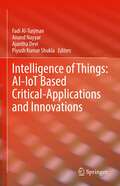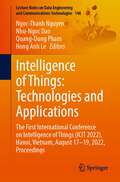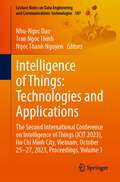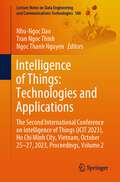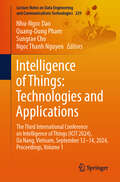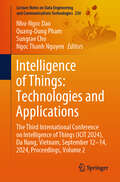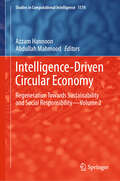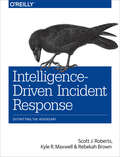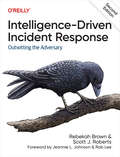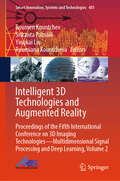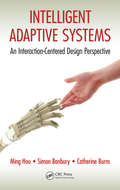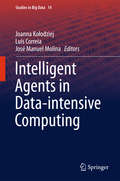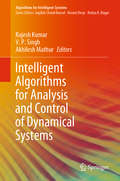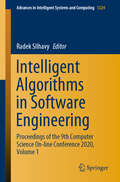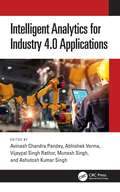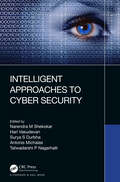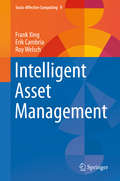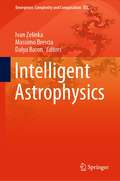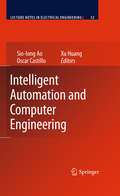- Table View
- List View
Intelligence for Embedded Systems
by Cesare AlippiAddressing current issues of which any engineer or computer scientist should be aware, this monograph is a response to the need to adopt a new computational paradigm as the methodological basis for designing pervasive embedded systems with sensor capabilities. The requirements of this paradigm are to control complexity, to limit cost and energy consumption and to provide adaptation and cognition abilities allowing the embedded system to interact proactively with the real world. The quest for such intelligence requires the formalization of a new generation of intelligent systems able to exploit advances in digital architectures and in sensing technologies. The book sheds light on the theory behind intelligence for embedded systems with specific focus on: · robustness (the robustness of a computational flow and its evaluation); · intelligence (how to mimic the adaptation and cognition abilities of the human brain), · the capacity to learn in non-stationary and evolving environments by detecting changes and reacting accordingly; and · a new paradigm that, by accepting results that are correct in probability, allows the complexity of the embedded application the be kept under control. Theories, concepts and methods are provided to motivate researchers in this exciting and timely interdisciplinary area. Applications such as porting a neural network from a high-precision platform to a digital embedded system and evaluatin g its robustness level are described. Examples show how the methodology introduced can be adopted in the case of cyber-physical systems to manage the interaction between embedded devices and physical world. Researchers and graduate students in computer science and various engineering-related disciplines will find the methods and approaches propounded in Intelligence for Embedded Systems of great interest. The book will also be an important resource for practitioners working on embedded systems and applications.
Intelligence for Future Cities: Planning Through Big Data and Urban Analytics (The Urban Book Series)
by Robert Goodspeed Raja Sengupta Christopher Pettit Marketta KyttäThis book contains a selection of the best papers presented at the Computational Urban Planning and Urban Management (CUPUM) conference, held in June 2023 at McGill University in Montreal, Quebec. Major themes of this book are smart cities, urban big data, and shared mobility. This book also contains chapters with cutting-edge research on urban modeling, walkability and bikeability analysis, and planning support systems (PSS).
Intelligence in Big Data Technologies—Beyond the Hype: Proceedings of ICBDCC 2019 (Advances in Intelligent Systems and Computing #1167)
by J. Dinesh Peter Amir H. Alavi Steven L. FernandesThis book is a compendium of the proceedings of the International Conference on Big-Data and Cloud Computing. The papers discuss the recent advances in the areas of big data analytics, data analytics in cloud, smart cities and grid, etc. This volume primarily focuses on the application of knowledge which promotes ideas for solving problems of the society through cutting-edge big-data technologies. The essays featured in this proceeding provide novel ideas that contribute for the growth of world class research and development. It will be useful to researchers in the area of advanced engineering sciences.
Intelligence in Chip: Integrated Sensors and Memristive Computing
by Alex James Bhaskar Choubey Alon AscoliIntelligence in Chips: Integrated Sensors and Memristive Computing is an authoritative resource that navigates the exciting landscape of in-memory computing, neuromorphic circuits, and memristive technologies. This book curates expert insights from leading researchers like Abu Sebastian, Alex James, Alon Ascoli, Arindam Basu, Cory Merkel, Fernando Corinto, Jason Eshraghian, Rainer Waser, Spiros Nikolaidis, Stephan Menzel, and Vishal Saxena, highlighting some of the important contributions in the field. Through a comprehensive collection of talks, readers will gain deep insights into how memristive neural computing is revolutionizing artificial intelligence.The book covers the latest innovations in memristor array computing, brain-inspired circuits, neuromorphic event-driven vision, bio-inspired computing, and nonlinear phenomena in biological systems. Each chapter is authored by a distinguished expert, offering a multi-perspective analysis on how emerging technologies are pushing the boundaries of edge-AI and mixed-signal hardware.Whether you're a researcher, engineer, or student, this book is an essential guide that explores the confluence of circuit theory, artificial intelligence, and memristor technology, providing readers with practical methodologies and visionary outlooks for the future.
Intelligence in IoT-enabled Smart Cities
by Fadi Al-TurjmanSmart Cities and intelligence are among the most significant topics in IoT. Intelligence in communication and infrastructure implementation is at the heart of this concept, and its development is a key issue in smart cities. This book addresses the challenges in realizing intelligence in smart cities and sensing platforms in the era of cloud computing and IoT, varying from cost and energy efficiency to availability and service quality. It focuses on both the design and implementation aspects of artificial intelligence approaches in smart cities and sensing applications that are enabled and supported by IoT paradigms, and mainly on data delivery approaches and their performability aspects.
Intelligence of Things: AI-IoT Based Critical-Applications and Innovations
by Fadi Al-Turjman Anand Nayyar Ajantha Devi Piyush Kumar ShuklaThis book presents recent technologies that explore artificial intelligence (AI) and its scope in Internet of Things (IoT) enabled areas for productivity and the betterment of society. The book aims at targeting audiences of several disciplines to share research, suggest solutions, and future trends in the field of AI using IoT. Rather than looking at the field from only a theoretical or only a practical perspective, this book unifies both aspects to give a holistic understanding of the AI paradigm for IoT. The book focuses on timely topics related to the field of AI enabled IoT applications at large. The book consists of four major parts: fundamentals, theoretical discussion, critical applications, and the learning algorithms. These contents shall include the basics, types, tools, and techniques of AI. Finally, applications of AI enabled IoT in several areas are presented including health, security, climate change, agricultural engineering, bioinformatics, biomedicine, smart applications, natural language processing, social and economic implications of AI enabled IoT, as well as robotics, sustainability, risk management, seismic data processing, smart grid management, text analysis, security, privacy, and ethics.
Intelligence of Things: The First International Conference on Intelligence of Things (ICIot 2022), Hanoi, Vietnam, August 17–19, 2022, Proceedings (Lecture Notes on Data Engineering and Communications Technologies #148)
by Ngoc-Thanh Nguyen Nhu-Ngoc Dao Quang-Dung Pham Hong Anh LeThis book constitutes the refereed proceedings of the First Conference on Intelligence of Things (ICIoT 2022), held in Hanoi, Vietnam, in August 2022. A total of 40 full papers in this book have been rigorously peer-reviewed and selected from over 100 submissions. The papers focused on the intelligence of things (AIoT) studies are organized in the following parts: theoretical intelligence analyses, intelligence services and applications, and intelligence service experiments. This book provides interested students and engineers with comprehensive and cutting-edge studies in the fields.
Intelligence of Things: The Second International Conference on Intelligence of Things (ICIT 2023), Ho Chi Minh City, Vietnam, October 25-27, 2023, Proceedings, Volume 1 (Lecture Notes on Data Engineering and Communications Technologies #187)
by Ngoc Thanh Nguyen Nhu-Ngoc Dao Tran Ngoc ThinhThis book aims to provide state-of-the-art knowledge in the field of Intelligence of Things to both academic and industrial readers. In particular, undergraduate, graduate, and researchers may find valuable information to drive their future research. This book is considered a reference for numerous courses such as Artificial Intelligence, Internet of Things, Intelligent Systems, and Mobile Networks. In the industrial area, this book provides information on recent studies in applying AI to IoT developments, which help to align and shorten R&D processes to introduce new classes of intelligent IoT products. This book provides a technical reference for interdisciplinary studies which utilize machine learning and IoT as tools in their fields such as constructional management, smart agriculture, Earth sciences and geo-spatial analysis, intelligent business, and digital transformation in education.
Intelligence of Things: The Second International Conference on Intelligence of Things (ICIT 2023), Ho Chi Minh City, Vietnam, October 25-27, 2023, Proceedings, Volume 2 (Lecture Notes on Data Engineering and Communications Technologies #188)
by Ngoc Thanh Nguyen Nhu-Ngoc Dao Tran Ngoc ThinhThis book aims to provide state-of-the-art knowledge in the field of Intelligence of Things to both academic and industrial readers. In particular, undergraduate, graduate, and researchers may find valuable information to drive their future research. This book is considered a reference for numerous courses such as Artificial Intelligence, Internet of Things, Intelligent Systems, and Mobile Networks. In the industrial area, this book provides information on recent studies in applying AI to IoT developments, which help to align and shorten R&D processes to introduce new classes of intelligent IoT products. This book provides a technical reference for interdisciplinary studies which utilize machine learning and IoT as tools in their fields such as constructional management, smart agriculture, Earth sciences and geo-spatial analysis, intelligent business, and digital transformation in education.
Intelligence of Things: The Third International Conference on Intelligence of Things (ICIT 2024), Da Nang, Vietnam, September 12-14, 2024, Proceedings, Volume 1 (Lecture Notes on Data Engineering and Communications Technologies #229)
by Ngoc Thanh Nguyen Nhu-Ngoc Dao Quang-Dung Pham Sungrae ChoThis book aims to provide state-of-the-art knowledge in the field of Intelligence of Things to both academic and industrial readers. In particular, undergraduate, graduate, and researchers may find valuable information to drive their future research. This book is considered a reference for numerous courses such as Artificial Intelligence, Internet of Things, Intelligent Systems, and Mobile Networks. In the industrial area, this book provides information on recent studies in applying AI to IoT developments, which help to align and shorten R&D processes to introduce new classes of intelligent IoT products.
Intelligence of Things: The Third International Conference on Intelligence of Things (ICIT 2024), Da Nang, Vietnam, September 12-14, 2024, Proceedings, Volume 2 (Lecture Notes on Data Engineering and Communications Technologies #230)
by Ngoc Thanh Nguyen Nhu-Ngoc Dao Quang-Dung Pham Sungrae ChoThis book aims to provide state-of-the-art knowledge in the field of Intelligence of Things to both academic and industrial readers. In particular, undergraduate, graduate, and researchers may find valuable information to drive their future research. This book is considered a reference for numerous courses such as Artificial Intelligence, Internet of Things, Intelligent Systems, and Mobile Networks. In the industrial area, this book provides information on recent studies in applying AI to IoT developments, which help to align and shorten R&D processes to introduce new classes of intelligent IoT products.
Intelligence-Driven Circular Economy: Regeneration Towards Sustainability and Social Responsibility—Volume 2 (Studies in Computational Intelligence #1174)
by Azzam Hannoon Abdullah MahmoodThis book provides a platform for scholars and researchers to present the latest insights and findings on the role of artificial intelligence and smart digital solutions in fostering the circular economy. Additionally, the book shades the lights on the vital role of circular economy in achieving sustainability and social responsibility. It covers a variety of research topics including circular economy, sustainability, AI applications, legislation and regulation, smart cities, social entrepreneurship and AI, digital transformation, knowledge management, and cybersecurity. This edited book serves as a reference and guide to graduate students, researchers, and academics conducting research and taking courses in artificial intelligence, sustainability, and the circular economy.
Intelligence-Driven Incident Response: Outwitting the Adversary
by Rebekah Brown Scott J RobertsUsing a well-conceived incident response plan in the aftermath of an online security breach enables your team to identify attackers and learn how they operate. But, only when you approach incident response with a cyber threat intelligence mindset will you truly understand the value of that information. With this practical guide, you’ll learn the fundamentals of intelligence analysis, as well as the best ways to incorporate these techniques into your incident response process.Each method reinforces the other: threat intelligence supports and augments incident response, while incident response generates useful threat intelligence. This book helps incident managers, malware analysts, reverse engineers, digital forensics specialists, and intelligence analysts understand, implement, and benefit from this relationship.In three parts, this in-depth book includes:The fundamentals: get an introduction to cyber threat intelligence, the intelligence process, the incident-response process, and how they all work togetherPractical application: walk through the intelligence-driven incident response (IDIR) process using the F3EAD process—Find, Fix Finish, Exploit, Analyze, and DisseminateThe way forward: explore big-picture aspects of IDIR that go beyond individual incident-response investigations, including intelligence team building
Intelligence-Driven Incident Response: Outwitting the Adversary
by Rebekah Brown Scott J. RobertsUsing a well-conceived incident response plan in the aftermath of an online security breach enables your team to identify attackers and learn how they operate. But only when you approach incident response with a cyber threat intelligence mindset will you truly understand the value of that information. In this updated second edition, you'll learn the fundamentals of intelligence analysis as well as the best ways to incorporate these techniques into your incident response process.Each method reinforces the other: threat intelligence supports and augments incident response, while incident response generates useful threat intelligence. This practical guide helps incident managers, malware analysts, reverse engineers, digital forensics specialists, and intelligence analysts understand, implement, and benefit from this relationship.In three parts, this in-depth book includes:The fundamentals: Get an introduction to cyberthreat intelligence, the intelligence process, the incident response process, and how they all work togetherPractical application: Walk through the intelligence-driven incident response (IDIR) process using the F3EAD process: Find, Fix, Finish, Exploit, Analyze, and DisseminateThe way forward: Explore big-picture aspects of IDIR that go beyond individual incident response investigations, including intelligence team building
Intelligent 3D Technologies and Augmented Reality: Proceedings of the Fifth International Conference on 3D Imaging Technologies—Multidimensional Signal Processing and Deep Learning, Volume 2 (Smart Innovation, Systems and Technologies #401)
by Srikanta Patnaik Roumen Kountchev Roumiana Kountcheva Yingkai LiuThis book presents high-quality research in the field of 3D imaging technology. The fifth edition of International Conference on 3D Imaging Technology (3DDIT-MSP&DL) continues the good traditions already established by the first four editions of the conference to provide a wide scientific forum for researchers, academia, and practitioners to exchange newest ideas and recent achievements in all aspects of image processing and analysis, together with their contemporary applications. The conference proceedings are published in two volumes. The main topics of the papers comprise famous trends such as: 3D image representation, 3D image technology, 3D images and graphics, and computing and 3D information technology. In these proceedings, special attention is paid at the 3D tensor image representation, the 3D content generation technologies, big data analysis, and also deep learning, artificial intelligence, the 3D image analysis and video understanding, the 3D virtual and augmented reality, and many related areas. The first volume contains papers in 3D image processing, transforms, and technologies. The second volume is about computing and information technologies, computer images, and graphics and related applications. The two volumes of the book cover a wide area of the aspects of the contemporary multidimensional imaging and the related future trends from data acquisition to real-world applications based on various techniques and theoretical approaches.
Intelligent Adaptive Systems: An Interaction-Centered Design Perspective
by Catherine Burns Simon Banbury Ming HouAs ubiquitous as the atmosphere, intelligent adaptive systems (IASs) surround us in our daily lives. When designed well, these systems sense users and their environments so that they can provide support in a manner that is not only responsive to the evolving situation, but unnoticed by the user. A synthesis of recent research and developments on IASs from the human factors (HF) and human–computer interaction (HCI) domains, Intelligent Adaptive Systems: An Interaction-Centered Design Perspective provides integrated design guidance and recommendations for researchers and system developers. The book explores a recognized lack of integration between the HF and HCI research communities, which has led to inconsistencies between the research approaches adopted, and a lack of exploitation of research from one field by the other. The authors integrate theories and methodologies from these domains to provide design recommendations for human–machine developers. They then establish design guidance through the review of conceptual frameworks, analytical methodologies, and design processes for intelligent adaptive systems. The book draws on case studies from the military, medical, and distance learning domains to illustrate intelligent system design to examine lessons learned.Outlining an interaction-centered perspective for designing an IAS, the book details methodologies for understanding human work in complex environments and offers understanding about why and how optimizing human–machine interaction should be central to the design of IASs. The authors present an analytical and design methodology as well as an implementation strategy that helps you choose the proper design framework for your needs.
Intelligent Agents in Data-intensive Computing
by Joanna Kołodziej Luís Correia José Manuel MolinaThis book presents new approaches that advance research in all aspects of agent-based models, technologies, simulations and implementations for data intensive applications. The nine chapters contain a review of recent cross-disciplinary approaches in cloud environments and multi-agent systems, and important formulations of data intensive problems in distributed computational environments together with the presentation of new agent-based tools to handle those problems and Big Data in general. This volume can serve as a reference for students, researchers and industry practitioners working in or interested in joining interdisciplinary work in the areas of data intensive computing and Big Data systems using emergent large-scale distributed computing paradigms. It will also allow newcomers to grasp key concepts and potential solutions on advanced topics of theory, models, technologies, system architectures and implementation of applications in Multi-Agent systems and data intensive computing.
Intelligent Algorithms for Analysis and Control of Dynamical Systems (Algorithms for Intelligent Systems)
by Rajesh Kumar V. P. Singh Akhilesh MathurThis book explores various intelligent algorithms including evolutionary algorithms, swarm intelligence-based algorithms for analysis and control of dynamical systems. Both single-input–single-output (SISO) and multi-input–multi-output (MIMO) systems are explored for analysis and control purposes. The applications of intelligent algorithm vary from approximation to optimal control design. The applications of intelligent algorithms not only improve understanding of a dynamical system but also enhance the control efficacy. The intelligent algorithms are now readily applied to all fields of control including linear control, nonlinear control, digital control, optimal control, etc. The book also discusses the main benefits attained due to the application of algorithms to analyze and control.
Intelligent Algorithms in Software Engineering: Proceedings of the 9th Computer Science On-line Conference 2020, Volume 1 (Advances in Intelligent Systems and Computing #1224)
by Radek SilhavyThis book gathers the refereed proceedings of the Intelligent Algorithms in Software Engineering Section of the 9th Computer Science On-line Conference 2020 (CSOC 2020), held on-line in April 2020.Software engineering research and its applications to intelligent algorithms have now assumed an essential role in computer science research. In this book, modern research methods, together with applications of machine and statistical learning in software engineering research, are presented.
Intelligent Analytics for Industry 4.0 Applications
by Abhishek Verma Ashutosh Kumar Singh Avinash Chandra Pandey Vijaypal Singh Rathor Munesh SinghThe advancements in intelligent decision-making techniques have elevated the efficiency of manufacturing industries and led to the start of the Industry 4.0 era. Industry 4.0 is revolutionizing the way companies manufacture, improve, and distribute their products. Manufacturers are integrating new technologies, including the Internet of Things (IoT), cloud computing and analytics, and artificial intelligence and machine learning, into their production facilities throughout their operations. In the past few years, intelligent analytics has emerged as a solution that examines both historical and real-time data to uncover performance insights. Because the amount of data that needs analysis is growing daily, advanced technologies are necessary to collect, arrange, and analyze incoming data. This approach enables businesses to detect valuable connections and trends and make decisions that boost overall performance. In Industry 4.0, intelligent analytics has a broader scope in terms of descriptive, predictive, and prescriptive subdomains. To this end, the book will aim to review and highlight the challenges faced by intelligent analytics in Industry 4.0 and present the recent developments done to address those challenges.
Intelligent Approaches to Cyber Security
by Hari Vasudevan Antonis Michalas Narendra M. Shekokar Surya S. Durbha Tatwadarshi P. NagarhalliIntelligent Approach to Cyber Security provides details on the important cyber security threats and its mitigation and the influence of Machine Learning, Deep Learning and Blockchain technologies in the realm of cyber security. Features: Role of Deep Learning and Machine Learning in the Field of Cyber Security Using ML to defend against cyber-attacks Using DL to defend against cyber-attacks Using blockchain to defend against cyber-attacks This reference text will be useful for students and researchers interested and working in future cyber security issues in the light of emerging technology in the cyber world.
Intelligent Asset Management (Socio-Affective Computing #9)
by Erik Cambria Frank Xing Roy WelschThis book presents a systematic application of recent advances in artificial intelligence (AI) to the problem of asset management. While natural language processing and text mining techniques, such as semantic representation, sentiment analysis, entity extraction, commonsense reasoning, and fact checking have been evolving for decades, finance theories have not yet fully considered and adapted to these ideas.In this unique, readable volume, the authors discuss integrating textual knowledge and market sentiment step-by-step, offering readers new insights into the most popular portfolio optimization theories: the Markowitz model and the Black-Litterman model. The authors also provide valuable visions of how AI technology-based infrastructures could cut the cost of and automate wealth management procedures.This inspiring book is a must-read for researchers and bankers interested in cutting-edge AI applications in finance.
Intelligent Astrophysics (Emergence, Complexity and Computation #39)
by Ivan Zelinka Massimo Brescia Dalya BaronThis present book discusses the application of the methods to astrophysical data from different perspectives. In this book, the reader will encounter interesting chapters that discuss data processing and pulsars, the complexity and information content of our universe, the use of tessellation in astronomy, characterization and classification of astronomical phenomena, identification of extragalactic objects, classification of pulsars and many other interesting chapters. The authors of these chapters are experts in their field and have been carefully selected to create this book so that the authors present to the community a representative publication that shows a unique fusion of artificial intelligence and astrophysics.
Intelligent Audio Analysis
by Björn W. SchullerThis book provides the reader with the knowledge necessary for comprehension of the field of Intelligent Audio Analysis. It firstly introduces standard methods and discusses the typical Intelligent Audio Analysis chain going from audio data to audio features to audio recognition. Further, an introduction to audio source separation, and enhancement and robustness are given. After the introductory parts, the book shows several applications for the three types of audio: speech, music, and general sound. Each task is shortly introduced, followed by a description of the specific data and methods applied, experiments and results, and a conclusion for this specific task. The books provides benchmark results and standardized test-beds for a broader range of audio analysis tasks. The main focus thereby lies on the parallel advancement of realism in audio analysis, as too often today's results are overly optimistic owing to idealized testing conditions, and it serves to stimulate synergies arising from transfer of methods and leads to a holistic audio analysis.
Intelligent Automation and Computer Engineering
by He Huang Oscar CastilloA large international conference in Intelligent Automation and Computer Engineering was held in Hong Kong, March 18-20, 2009, under the auspices of the International MultiConference of Engineers and Computer Scientists (IMECS 2009). The IMECS is organized by the International Association of Engineers (IAENG). Intelligent Automation and Computer Engineering contains 37 revised and extended research articles written by prominent researchers participating in the conference. Topics covered include artificial intelligence, decision supporting systems, automated planning, automation systems, control engineering, systems identification, modelling and simulation, communication systems, signal processing, and industrial applications. Intelligent Automation and Computer Engineering offers the state of the art of tremendous advances in intelligent automation and computer engineering and also serves as an excellent reference text for researchers and graduate students, working on intelligent automation and computer engineering.
